Understanding Business Organizations: Types, Structures, Functions, and Culture
VerifiedAdded on 2023/06/10
|8
|2225
|212
AI Summary
This report covers the different types of business organizations, including sole proprietorship, partnership, and limited company, and their advantages and disadvantages. It also discusses tall and flat organizational structures, business functions such as human resource management, production, and operations, and the impact of organizational culture on success. The subject of this report is MGBBT0UBN - Understanding Business Organizations.
Contribute Materials
Your contribution can guide someone’s learning journey. Share your
documents today.
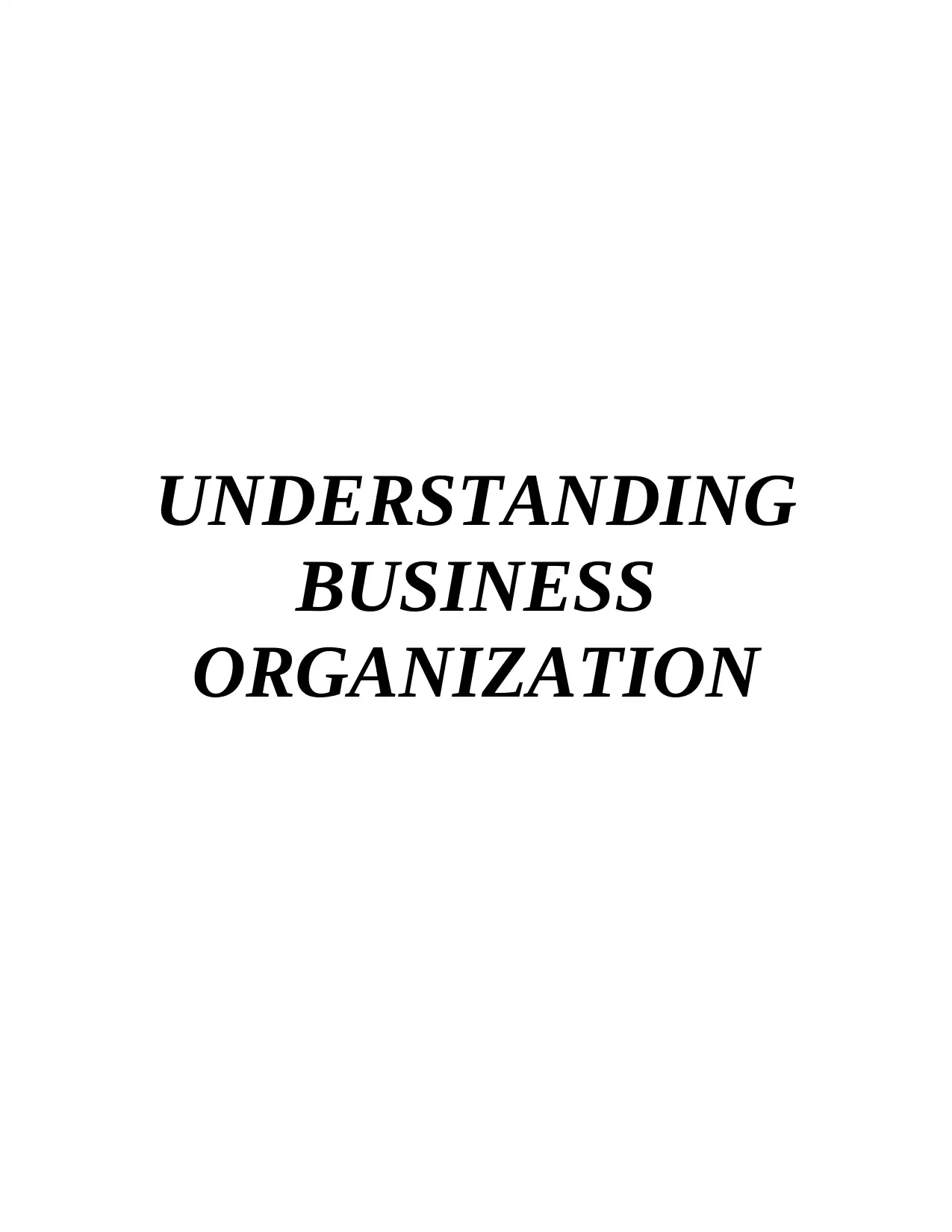
UNDERSTANDING
BUSINESS
ORGANIZATION
BUSINESS
ORGANIZATION
Secure Best Marks with AI Grader
Need help grading? Try our AI Grader for instant feedback on your assignments.
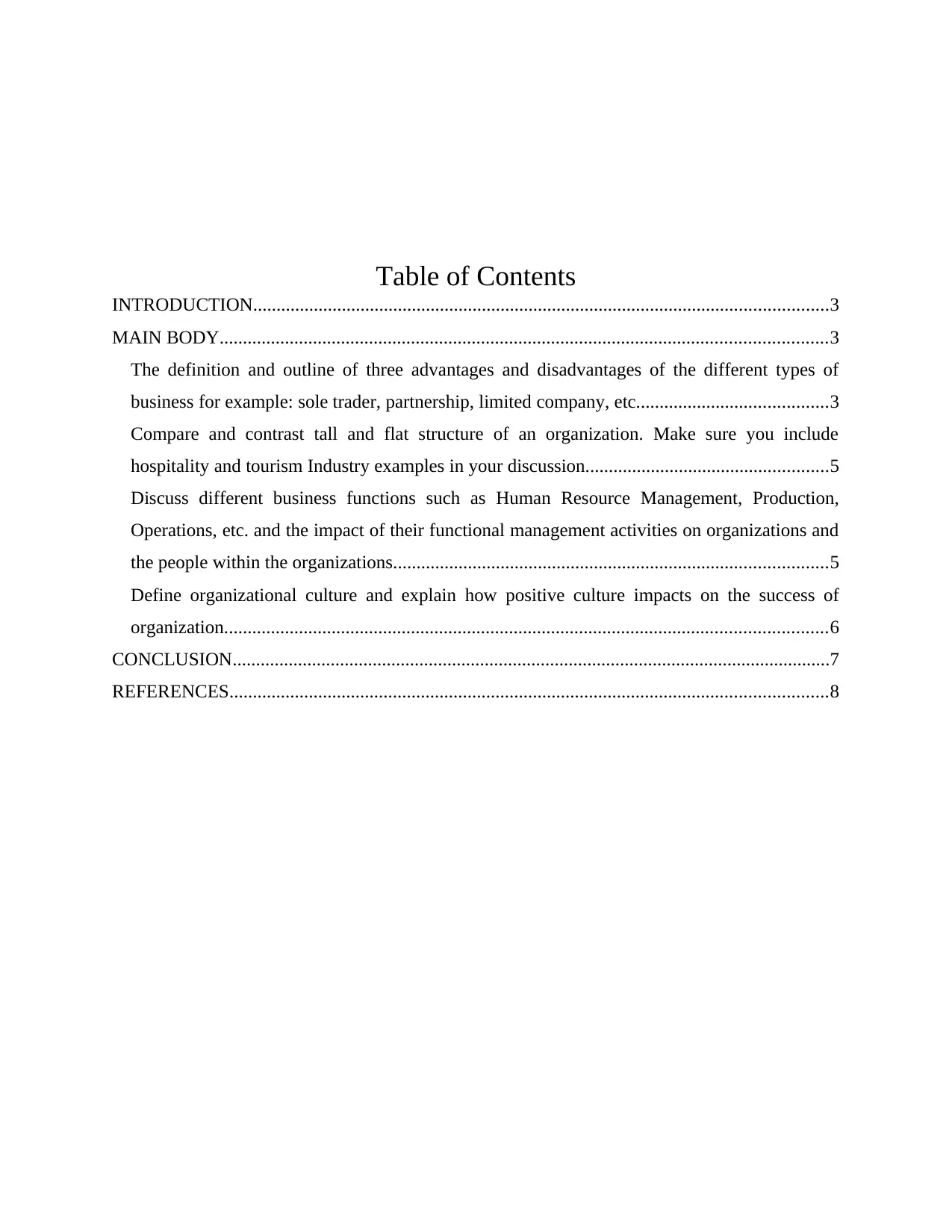
Table of Contents
INTRODUCTION...........................................................................................................................3
MAIN BODY..................................................................................................................................3
The definition and outline of three advantages and disadvantages of the different types of
business for example: sole trader, partnership, limited company, etc.........................................3
Compare and contrast tall and flat structure of an organization. Make sure you include
hospitality and tourism Industry examples in your discussion....................................................5
Discuss different business functions such as Human Resource Management, Production,
Operations, etc. and the impact of their functional management activities on organizations and
the people within the organizations.............................................................................................5
Define organizational culture and explain how positive culture impacts on the success of
organization.................................................................................................................................6
CONCLUSION................................................................................................................................7
REFERENCES................................................................................................................................8
INTRODUCTION...........................................................................................................................3
MAIN BODY..................................................................................................................................3
The definition and outline of three advantages and disadvantages of the different types of
business for example: sole trader, partnership, limited company, etc.........................................3
Compare and contrast tall and flat structure of an organization. Make sure you include
hospitality and tourism Industry examples in your discussion....................................................5
Discuss different business functions such as Human Resource Management, Production,
Operations, etc. and the impact of their functional management activities on organizations and
the people within the organizations.............................................................................................5
Define organizational culture and explain how positive culture impacts on the success of
organization.................................................................................................................................6
CONCLUSION................................................................................................................................7
REFERENCES................................................................................................................................8
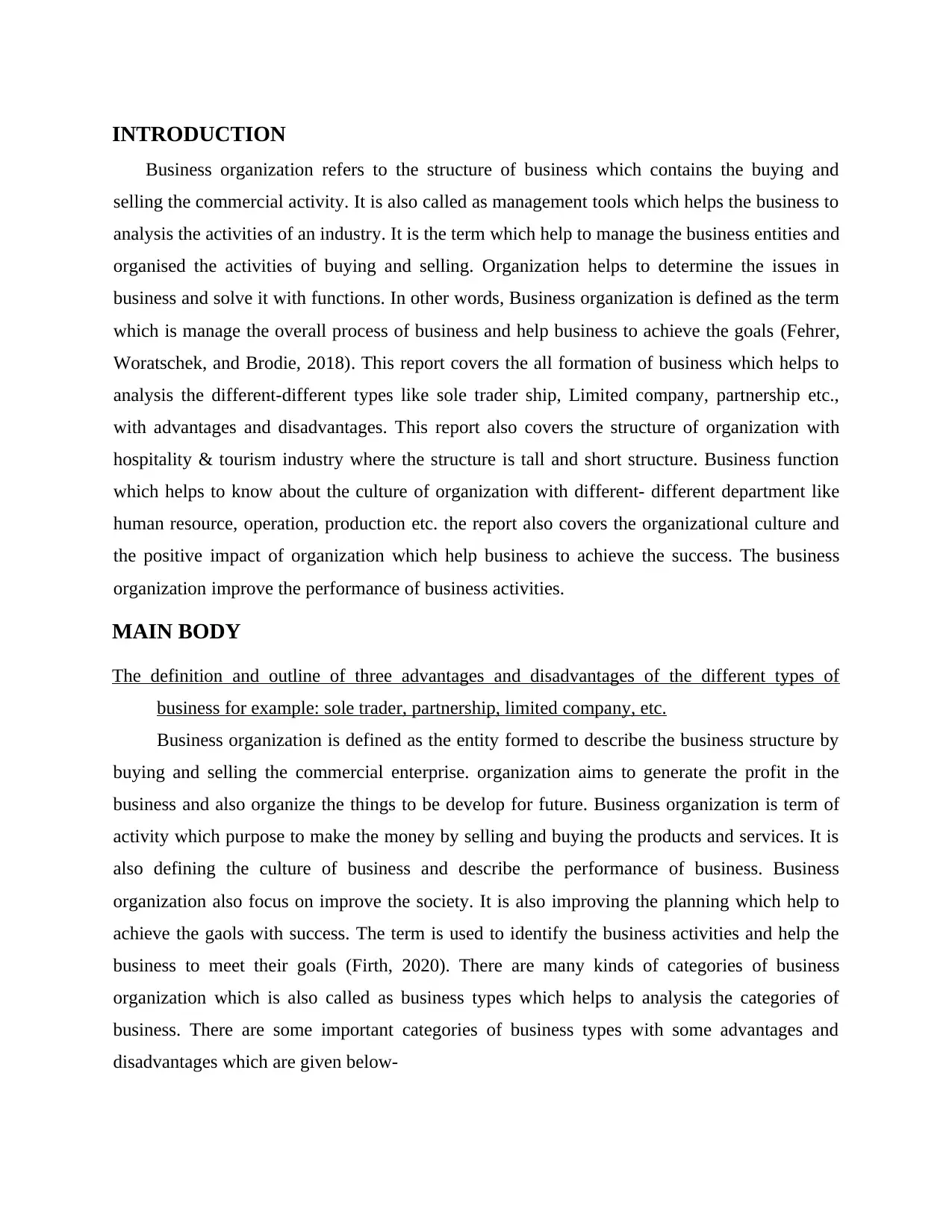
INTRODUCTION
Business organization refers to the structure of business which contains the buying and
selling the commercial activity. It is also called as management tools which helps the business to
analysis the activities of an industry. It is the term which help to manage the business entities and
organised the activities of buying and selling. Organization helps to determine the issues in
business and solve it with functions. In other words, Business organization is defined as the term
which is manage the overall process of business and help business to achieve the goals (Fehrer,
Woratschek, and Brodie, 2018). This report covers the all formation of business which helps to
analysis the different-different types like sole trader ship, Limited company, partnership etc.,
with advantages and disadvantages. This report also covers the structure of organization with
hospitality & tourism industry where the structure is tall and short structure. Business function
which helps to know about the culture of organization with different- different department like
human resource, operation, production etc. the report also covers the organizational culture and
the positive impact of organization which help business to achieve the success. The business
organization improve the performance of business activities.
MAIN BODY
The definition and outline of three advantages and disadvantages of the different types of
business for example: sole trader, partnership, limited company, etc.
Business organization is defined as the entity formed to describe the business structure by
buying and selling the commercial enterprise. organization aims to generate the profit in the
business and also organize the things to be develop for future. Business organization is term of
activity which purpose to make the money by selling and buying the products and services. It is
also defining the culture of business and describe the performance of business. Business
organization also focus on improve the society. It is also improving the planning which help to
achieve the gaols with success. The term is used to identify the business activities and help the
business to meet their goals (Firth, 2020). There are many kinds of categories of business
organization which is also called as business types which helps to analysis the categories of
business. There are some important categories of business types with some advantages and
disadvantages which are given below-
Business organization refers to the structure of business which contains the buying and
selling the commercial activity. It is also called as management tools which helps the business to
analysis the activities of an industry. It is the term which help to manage the business entities and
organised the activities of buying and selling. Organization helps to determine the issues in
business and solve it with functions. In other words, Business organization is defined as the term
which is manage the overall process of business and help business to achieve the goals (Fehrer,
Woratschek, and Brodie, 2018). This report covers the all formation of business which helps to
analysis the different-different types like sole trader ship, Limited company, partnership etc.,
with advantages and disadvantages. This report also covers the structure of organization with
hospitality & tourism industry where the structure is tall and short structure. Business function
which helps to know about the culture of organization with different- different department like
human resource, operation, production etc. the report also covers the organizational culture and
the positive impact of organization which help business to achieve the success. The business
organization improve the performance of business activities.
MAIN BODY
The definition and outline of three advantages and disadvantages of the different types of
business for example: sole trader, partnership, limited company, etc.
Business organization is defined as the entity formed to describe the business structure by
buying and selling the commercial enterprise. organization aims to generate the profit in the
business and also organize the things to be develop for future. Business organization is term of
activity which purpose to make the money by selling and buying the products and services. It is
also defining the culture of business and describe the performance of business. Business
organization also focus on improve the society. It is also improving the planning which help to
achieve the gaols with success. The term is used to identify the business activities and help the
business to meet their goals (Firth, 2020). There are many kinds of categories of business
organization which is also called as business types which helps to analysis the categories of
business. There are some important categories of business types with some advantages and
disadvantages which are given below-
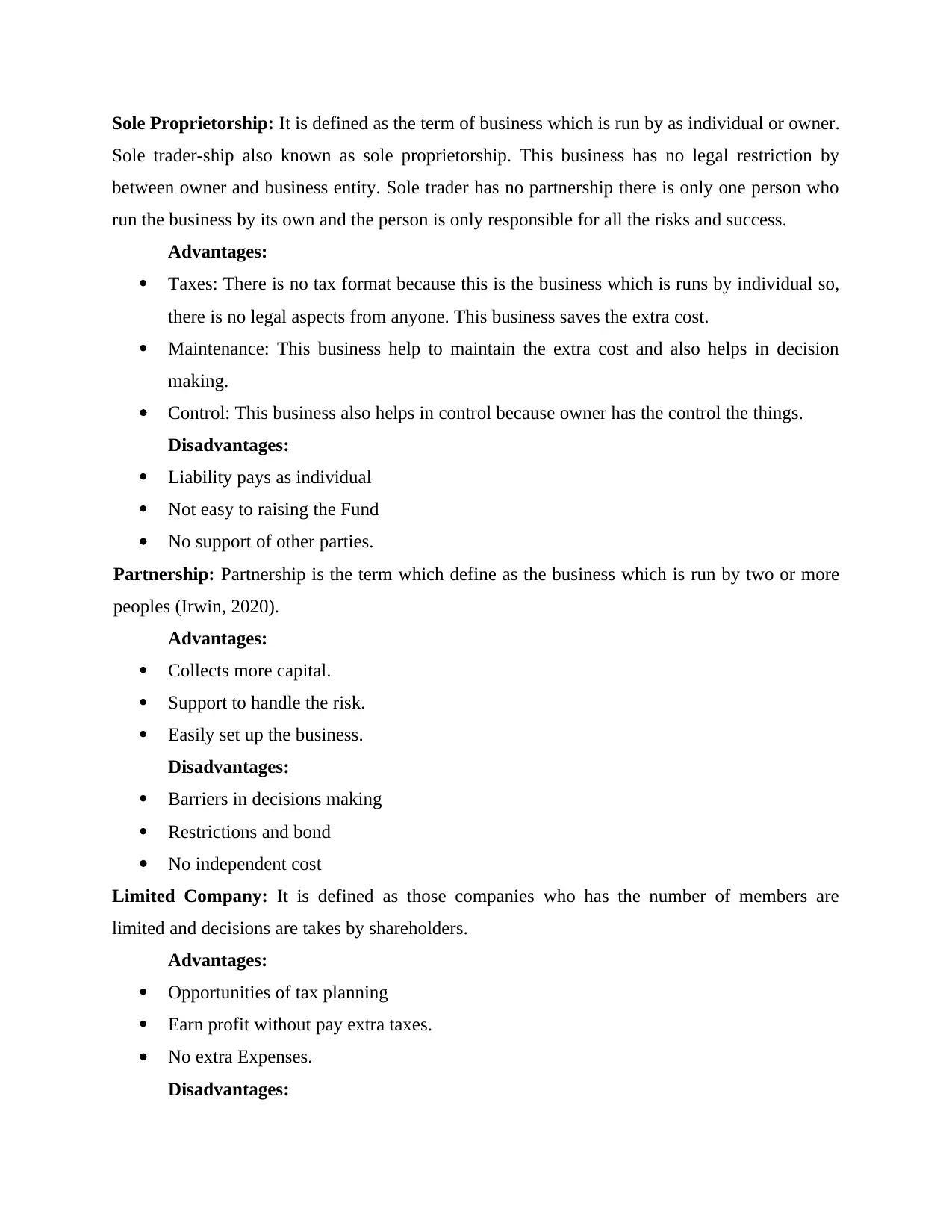
Sole Proprietorship: It is defined as the term of business which is run by as individual or owner.
Sole trader-ship also known as sole proprietorship. This business has no legal restriction by
between owner and business entity. Sole trader has no partnership there is only one person who
run the business by its own and the person is only responsible for all the risks and success.
Advantages:
Taxes: There is no tax format because this is the business which is runs by individual so,
there is no legal aspects from anyone. This business saves the extra cost.
Maintenance: This business help to maintain the extra cost and also helps in decision
making.
Control: This business also helps in control because owner has the control the things.
Disadvantages:
Liability pays as individual
Not easy to raising the Fund
No support of other parties.
Partnership: Partnership is the term which define as the business which is run by two or more
peoples (Irwin, 2020).
Advantages:
Collects more capital.
Support to handle the risk.
Easily set up the business.
Disadvantages:
Barriers in decisions making
Restrictions and bond
No independent cost
Limited Company: It is defined as those companies who has the number of members are
limited and decisions are takes by shareholders.
Advantages:
Opportunities of tax planning
Earn profit without pay extra taxes.
No extra Expenses.
Disadvantages:
Sole trader-ship also known as sole proprietorship. This business has no legal restriction by
between owner and business entity. Sole trader has no partnership there is only one person who
run the business by its own and the person is only responsible for all the risks and success.
Advantages:
Taxes: There is no tax format because this is the business which is runs by individual so,
there is no legal aspects from anyone. This business saves the extra cost.
Maintenance: This business help to maintain the extra cost and also helps in decision
making.
Control: This business also helps in control because owner has the control the things.
Disadvantages:
Liability pays as individual
Not easy to raising the Fund
No support of other parties.
Partnership: Partnership is the term which define as the business which is run by two or more
peoples (Irwin, 2020).
Advantages:
Collects more capital.
Support to handle the risk.
Easily set up the business.
Disadvantages:
Barriers in decisions making
Restrictions and bond
No independent cost
Limited Company: It is defined as those companies who has the number of members are
limited and decisions are takes by shareholders.
Advantages:
Opportunities of tax planning
Earn profit without pay extra taxes.
No extra Expenses.
Disadvantages:
Secure Best Marks with AI Grader
Need help grading? Try our AI Grader for instant feedback on your assignments.
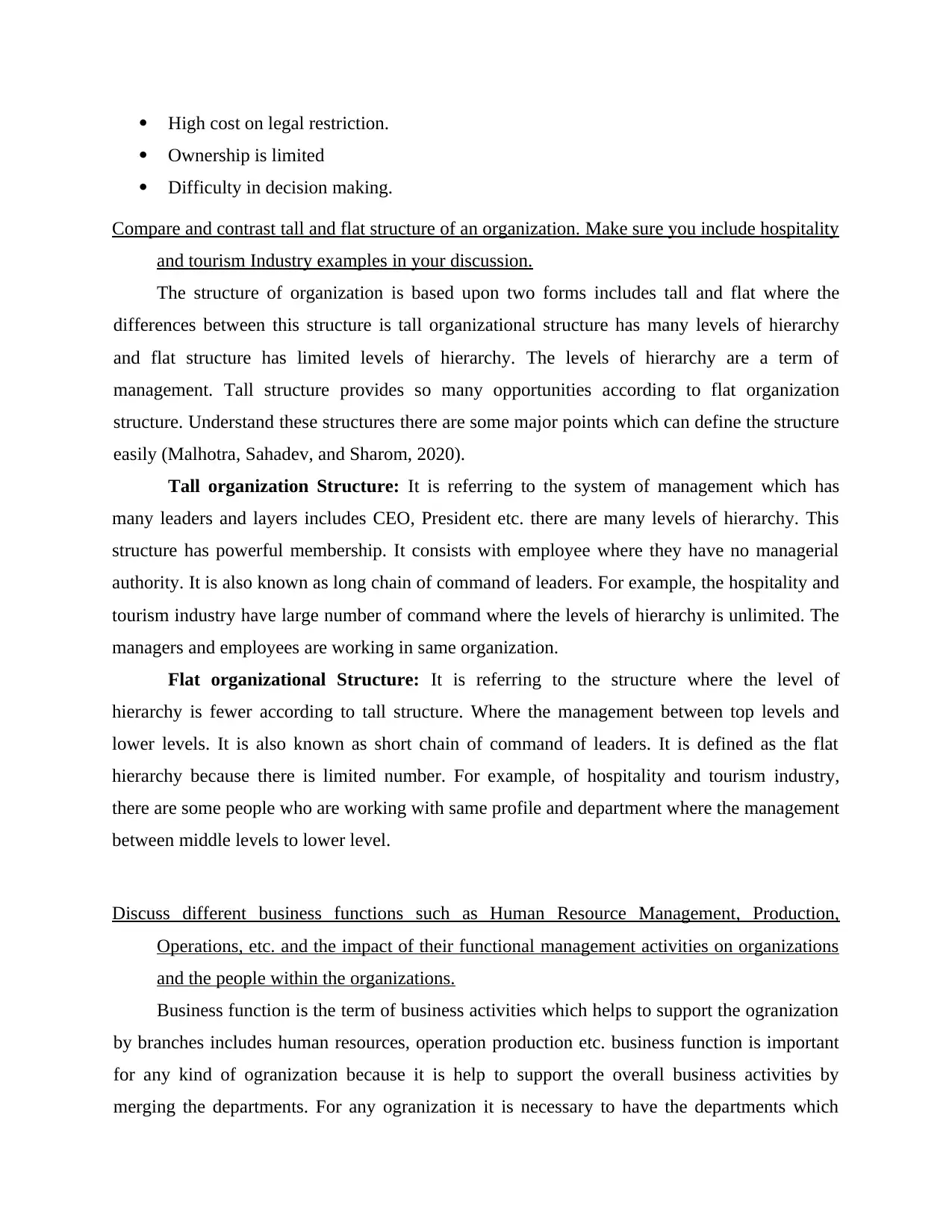
High cost on legal restriction.
Ownership is limited
Difficulty in decision making.
Compare and contrast tall and flat structure of an organization. Make sure you include hospitality
and tourism Industry examples in your discussion.
The structure of organization is based upon two forms includes tall and flat where the
differences between this structure is tall organizational structure has many levels of hierarchy
and flat structure has limited levels of hierarchy. The levels of hierarchy are a term of
management. Tall structure provides so many opportunities according to flat organization
structure. Understand these structures there are some major points which can define the structure
easily (Malhotra, Sahadev, and Sharom, 2020).
Tall organization Structure: It is referring to the system of management which has
many leaders and layers includes CEO, President etc. there are many levels of hierarchy. This
structure has powerful membership. It consists with employee where they have no managerial
authority. It is also known as long chain of command of leaders. For example, the hospitality and
tourism industry have large number of command where the levels of hierarchy is unlimited. The
managers and employees are working in same organization.
Flat organizational Structure: It is referring to the structure where the level of
hierarchy is fewer according to tall structure. Where the management between top levels and
lower levels. It is also known as short chain of command of leaders. It is defined as the flat
hierarchy because there is limited number. For example, of hospitality and tourism industry,
there are some people who are working with same profile and department where the management
between middle levels to lower level.
Discuss different business functions such as Human Resource Management, Production,
Operations, etc. and the impact of their functional management activities on organizations
and the people within the organizations.
Business function is the term of business activities which helps to support the ogranization
by branches includes human resources, operation production etc. business function is important
for any kind of ogranization because it is help to support the overall business activities by
merging the departments. For any ogranization it is necessary to have the departments which
Ownership is limited
Difficulty in decision making.
Compare and contrast tall and flat structure of an organization. Make sure you include hospitality
and tourism Industry examples in your discussion.
The structure of organization is based upon two forms includes tall and flat where the
differences between this structure is tall organizational structure has many levels of hierarchy
and flat structure has limited levels of hierarchy. The levels of hierarchy are a term of
management. Tall structure provides so many opportunities according to flat organization
structure. Understand these structures there are some major points which can define the structure
easily (Malhotra, Sahadev, and Sharom, 2020).
Tall organization Structure: It is referring to the system of management which has
many leaders and layers includes CEO, President etc. there are many levels of hierarchy. This
structure has powerful membership. It consists with employee where they have no managerial
authority. It is also known as long chain of command of leaders. For example, the hospitality and
tourism industry have large number of command where the levels of hierarchy is unlimited. The
managers and employees are working in same organization.
Flat organizational Structure: It is referring to the structure where the level of
hierarchy is fewer according to tall structure. Where the management between top levels and
lower levels. It is also known as short chain of command of leaders. It is defined as the flat
hierarchy because there is limited number. For example, of hospitality and tourism industry,
there are some people who are working with same profile and department where the management
between middle levels to lower level.
Discuss different business functions such as Human Resource Management, Production,
Operations, etc. and the impact of their functional management activities on organizations
and the people within the organizations.
Business function is the term of business activities which helps to support the ogranization
by branches includes human resources, operation production etc. business function is important
for any kind of ogranization because it is help to support the overall business activities by
merging the departments. For any ogranization it is necessary to have the departments which
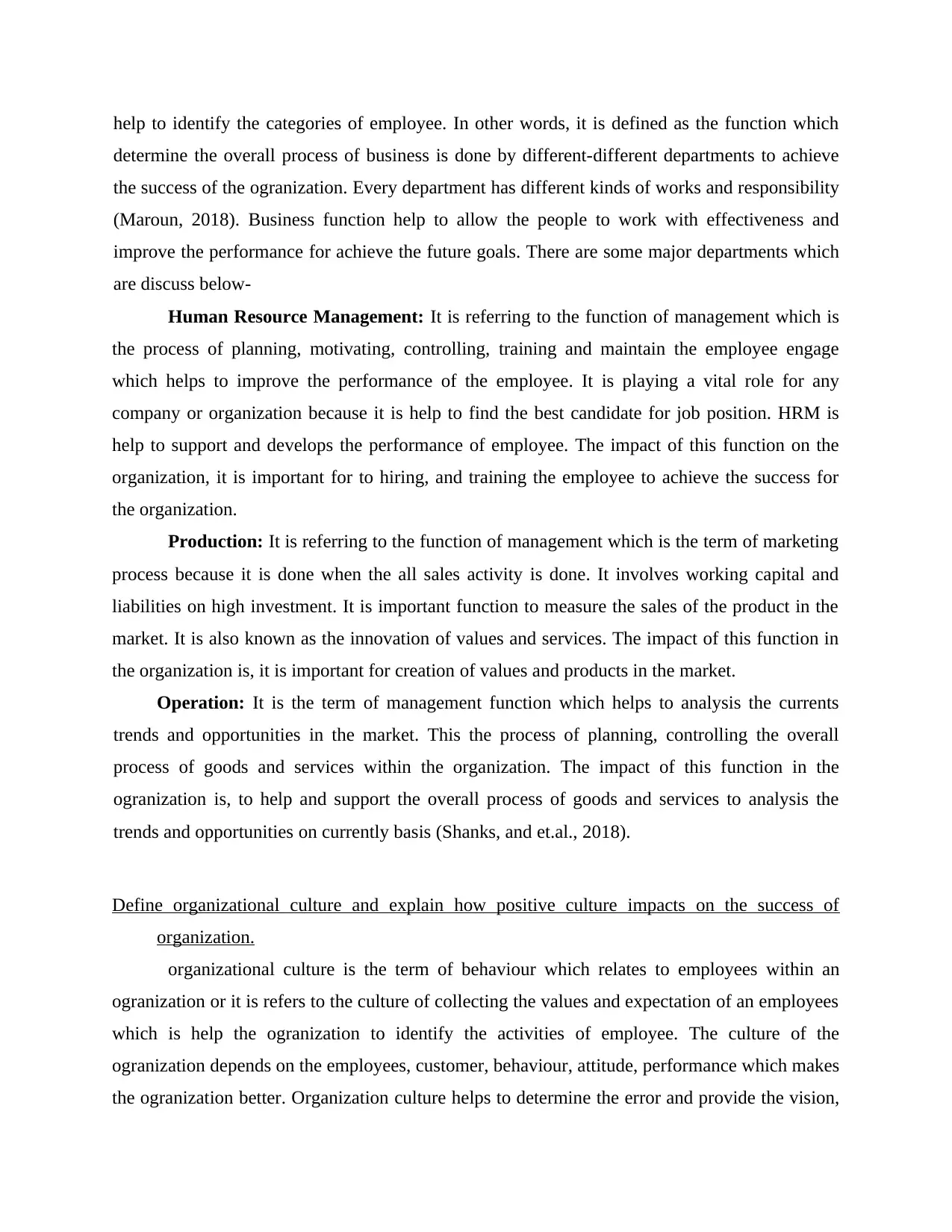
help to identify the categories of employee. In other words, it is defined as the function which
determine the overall process of business is done by different-different departments to achieve
the success of the ogranization. Every department has different kinds of works and responsibility
(Maroun, 2018). Business function help to allow the people to work with effectiveness and
improve the performance for achieve the future goals. There are some major departments which
are discuss below-
Human Resource Management: It is referring to the function of management which is
the process of planning, motivating, controlling, training and maintain the employee engage
which helps to improve the performance of the employee. It is playing a vital role for any
company or organization because it is help to find the best candidate for job position. HRM is
help to support and develops the performance of employee. The impact of this function on the
organization, it is important for to hiring, and training the employee to achieve the success for
the organization.
Production: It is referring to the function of management which is the term of marketing
process because it is done when the all sales activity is done. It involves working capital and
liabilities on high investment. It is important function to measure the sales of the product in the
market. It is also known as the innovation of values and services. The impact of this function in
the organization is, it is important for creation of values and products in the market.
Operation: It is the term of management function which helps to analysis the currents
trends and opportunities in the market. This the process of planning, controlling the overall
process of goods and services within the organization. The impact of this function in the
ogranization is, to help and support the overall process of goods and services to analysis the
trends and opportunities on currently basis (Shanks, and et.al., 2018).
Define organizational culture and explain how positive culture impacts on the success of
organization.
organizational culture is the term of behaviour which relates to employees within an
ogranization or it is refers to the culture of collecting the values and expectation of an employees
which is help the ogranization to identify the activities of employee. The culture of the
ogranization depends on the employees, customer, behaviour, attitude, performance which makes
the ogranization better. Organization culture helps to determine the error and provide the vision,
determine the overall process of business is done by different-different departments to achieve
the success of the ogranization. Every department has different kinds of works and responsibility
(Maroun, 2018). Business function help to allow the people to work with effectiveness and
improve the performance for achieve the future goals. There are some major departments which
are discuss below-
Human Resource Management: It is referring to the function of management which is
the process of planning, motivating, controlling, training and maintain the employee engage
which helps to improve the performance of the employee. It is playing a vital role for any
company or organization because it is help to find the best candidate for job position. HRM is
help to support and develops the performance of employee. The impact of this function on the
organization, it is important for to hiring, and training the employee to achieve the success for
the organization.
Production: It is referring to the function of management which is the term of marketing
process because it is done when the all sales activity is done. It involves working capital and
liabilities on high investment. It is important function to measure the sales of the product in the
market. It is also known as the innovation of values and services. The impact of this function in
the organization is, it is important for creation of values and products in the market.
Operation: It is the term of management function which helps to analysis the currents
trends and opportunities in the market. This the process of planning, controlling the overall
process of goods and services within the organization. The impact of this function in the
ogranization is, to help and support the overall process of goods and services to analysis the
trends and opportunities on currently basis (Shanks, and et.al., 2018).
Define organizational culture and explain how positive culture impacts on the success of
organization.
organizational culture is the term of behaviour which relates to employees within an
ogranization or it is refers to the culture of collecting the values and expectation of an employees
which is help the ogranization to identify the activities of employee. The culture of the
ogranization depends on the employees, customer, behaviour, attitude, performance which makes
the ogranization better. Organization culture helps to determine the error and provide the vision,
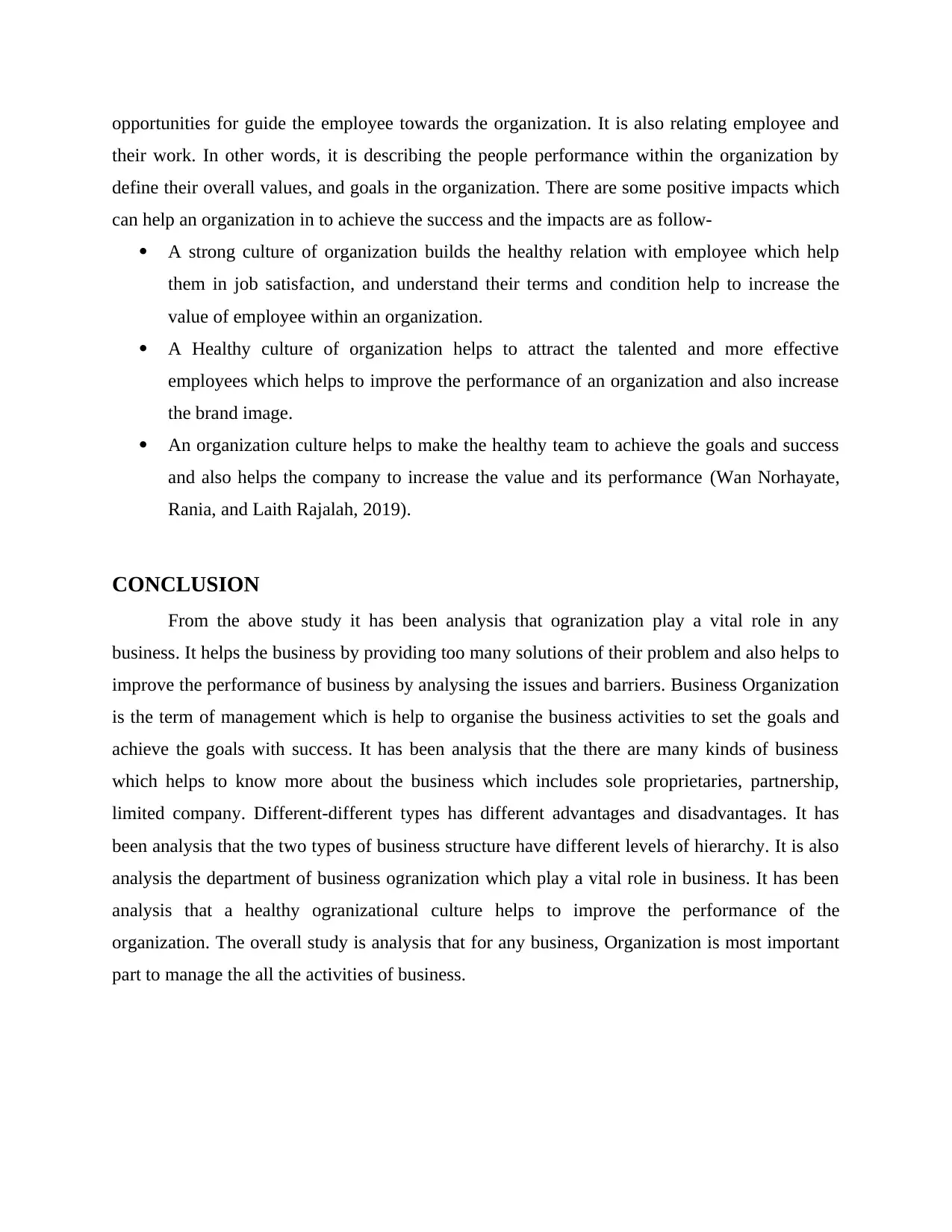
opportunities for guide the employee towards the organization. It is also relating employee and
their work. In other words, it is describing the people performance within the organization by
define their overall values, and goals in the organization. There are some positive impacts which
can help an organization in to achieve the success and the impacts are as follow-
A strong culture of organization builds the healthy relation with employee which help
them in job satisfaction, and understand their terms and condition help to increase the
value of employee within an organization.
A Healthy culture of organization helps to attract the talented and more effective
employees which helps to improve the performance of an organization and also increase
the brand image.
An organization culture helps to make the healthy team to achieve the goals and success
and also helps the company to increase the value and its performance (Wan Norhayate,
Rania, and Laith Rajalah, 2019).
CONCLUSION
From the above study it has been analysis that ogranization play a vital role in any
business. It helps the business by providing too many solutions of their problem and also helps to
improve the performance of business by analysing the issues and barriers. Business Organization
is the term of management which is help to organise the business activities to set the goals and
achieve the goals with success. It has been analysis that the there are many kinds of business
which helps to know more about the business which includes sole proprietaries, partnership,
limited company. Different-different types has different advantages and disadvantages. It has
been analysis that the two types of business structure have different levels of hierarchy. It is also
analysis the department of business ogranization which play a vital role in business. It has been
analysis that a healthy ogranizational culture helps to improve the performance of the
organization. The overall study is analysis that for any business, Organization is most important
part to manage the all the activities of business.
their work. In other words, it is describing the people performance within the organization by
define their overall values, and goals in the organization. There are some positive impacts which
can help an organization in to achieve the success and the impacts are as follow-
A strong culture of organization builds the healthy relation with employee which help
them in job satisfaction, and understand their terms and condition help to increase the
value of employee within an organization.
A Healthy culture of organization helps to attract the talented and more effective
employees which helps to improve the performance of an organization and also increase
the brand image.
An organization culture helps to make the healthy team to achieve the goals and success
and also helps the company to increase the value and its performance (Wan Norhayate,
Rania, and Laith Rajalah, 2019).
CONCLUSION
From the above study it has been analysis that ogranization play a vital role in any
business. It helps the business by providing too many solutions of their problem and also helps to
improve the performance of business by analysing the issues and barriers. Business Organization
is the term of management which is help to organise the business activities to set the goals and
achieve the goals with success. It has been analysis that the there are many kinds of business
which helps to know more about the business which includes sole proprietaries, partnership,
limited company. Different-different types has different advantages and disadvantages. It has
been analysis that the two types of business structure have different levels of hierarchy. It is also
analysis the department of business ogranization which play a vital role in business. It has been
analysis that a healthy ogranizational culture helps to improve the performance of the
organization. The overall study is analysis that for any business, Organization is most important
part to manage the all the activities of business.
Paraphrase This Document
Need a fresh take? Get an instant paraphrase of this document with our AI Paraphraser
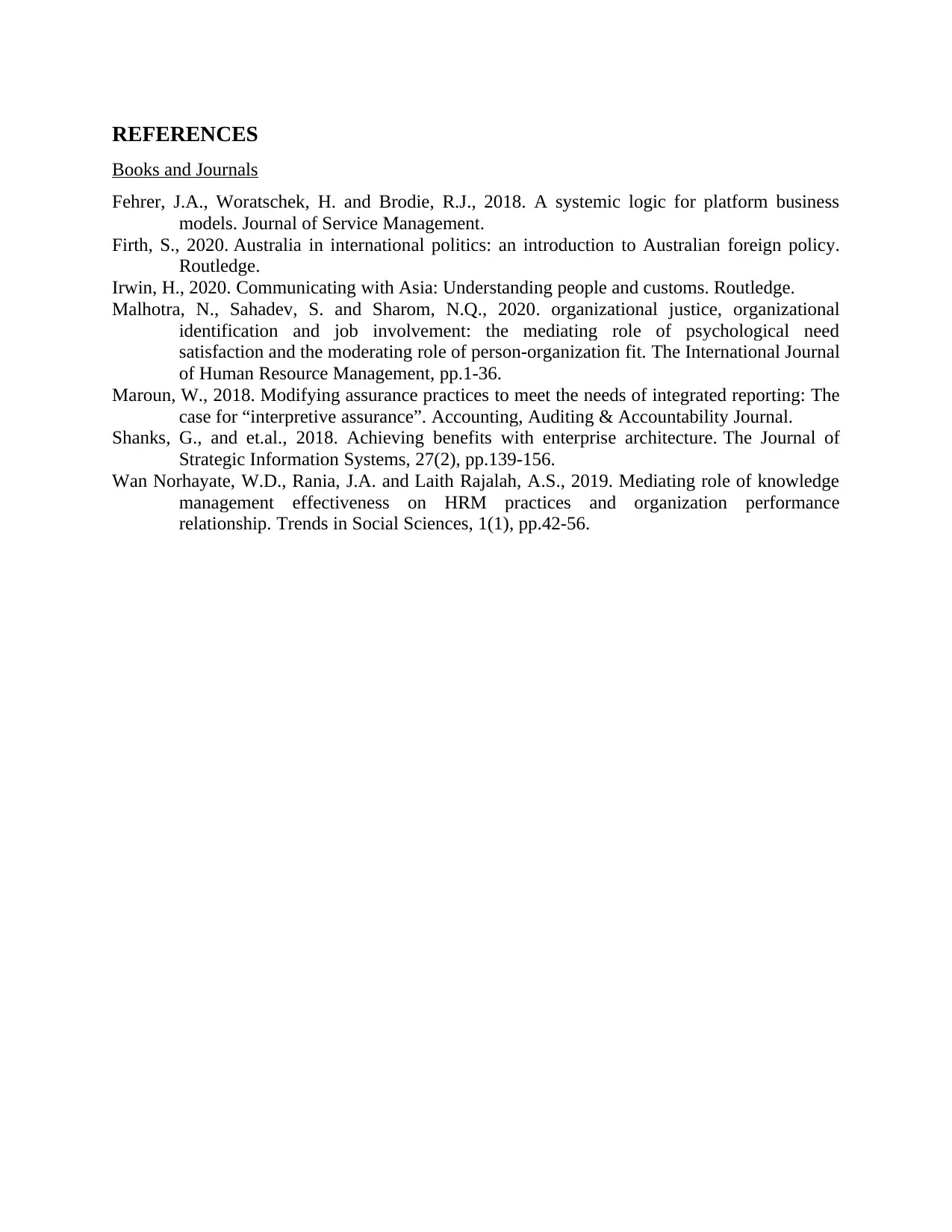
REFERENCES
Books and Journals
Fehrer, J.A., Woratschek, H. and Brodie, R.J., 2018. A systemic logic for platform business
models. Journal of Service Management.
Firth, S., 2020. Australia in international politics: an introduction to Australian foreign policy.
Routledge.
Irwin, H., 2020. Communicating with Asia: Understanding people and customs. Routledge.
Malhotra, N., Sahadev, S. and Sharom, N.Q., 2020. organizational justice, organizational
identification and job involvement: the mediating role of psychological need
satisfaction and the moderating role of person-organization fit. The International Journal
of Human Resource Management, pp.1-36.
Maroun, W., 2018. Modifying assurance practices to meet the needs of integrated reporting: The
case for “interpretive assurance”. Accounting, Auditing & Accountability Journal.
Shanks, G., and et.al., 2018. Achieving benefits with enterprise architecture. The Journal of
Strategic Information Systems, 27(2), pp.139-156.
Wan Norhayate, W.D., Rania, J.A. and Laith Rajalah, A.S., 2019. Mediating role of knowledge
management effectiveness on HRM practices and organization performance
relationship. Trends in Social Sciences, 1(1), pp.42-56.
Books and Journals
Fehrer, J.A., Woratschek, H. and Brodie, R.J., 2018. A systemic logic for platform business
models. Journal of Service Management.
Firth, S., 2020. Australia in international politics: an introduction to Australian foreign policy.
Routledge.
Irwin, H., 2020. Communicating with Asia: Understanding people and customs. Routledge.
Malhotra, N., Sahadev, S. and Sharom, N.Q., 2020. organizational justice, organizational
identification and job involvement: the mediating role of psychological need
satisfaction and the moderating role of person-organization fit. The International Journal
of Human Resource Management, pp.1-36.
Maroun, W., 2018. Modifying assurance practices to meet the needs of integrated reporting: The
case for “interpretive assurance”. Accounting, Auditing & Accountability Journal.
Shanks, G., and et.al., 2018. Achieving benefits with enterprise architecture. The Journal of
Strategic Information Systems, 27(2), pp.139-156.
Wan Norhayate, W.D., Rania, J.A. and Laith Rajalah, A.S., 2019. Mediating role of knowledge
management effectiveness on HRM practices and organization performance
relationship. Trends in Social Sciences, 1(1), pp.42-56.
1 out of 8
Related Documents
Your All-in-One AI-Powered Toolkit for Academic Success.
+13062052269
info@desklib.com
Available 24*7 on WhatsApp / Email
![[object Object]](/_next/static/media/star-bottom.7253800d.svg)
Unlock your academic potential
© 2024 | Zucol Services PVT LTD | All rights reserved.

